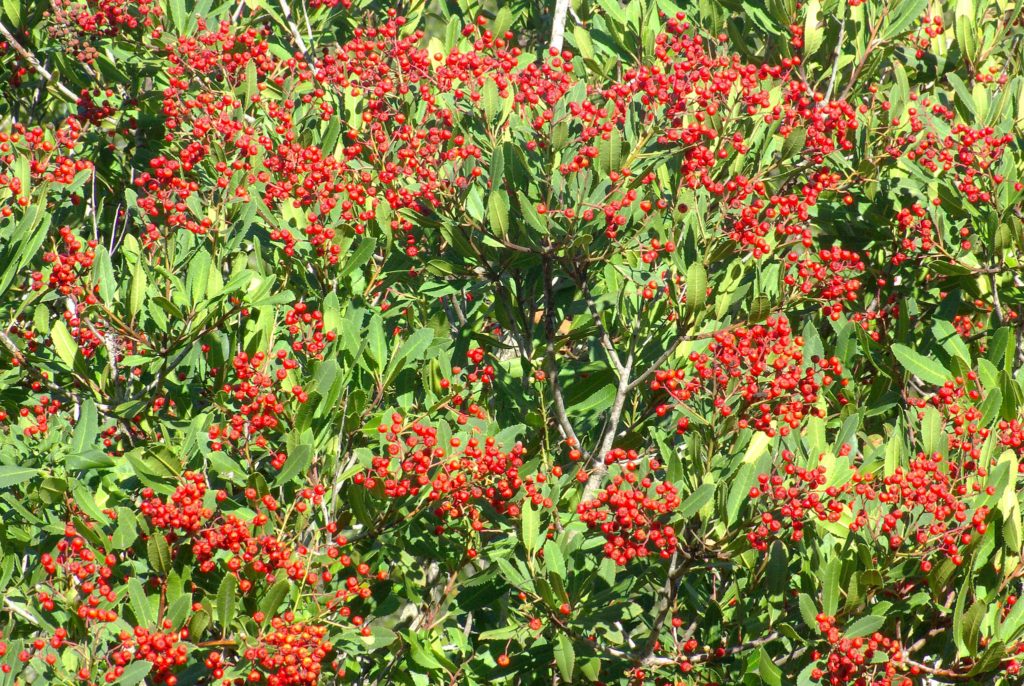- About Us
- Our Work
- Tree Info
- Get Involved
- Blog
- Support Us
By Canopy Team on December 16, 2019

Photo by Alan Schmierer via Flickr
Tree Spotlight Series: Follow along as we learn about the fascinating trees that live among us. This series is in partnership with Rhee Lab in the Plant Biology Department of the Carnegie Institution for Science.
Other posts in the series: ginkgo biloba, Douglas fir, giant sequoia, Chinese tallow, silver-dollar gum, Monterey pine, green dracaena, coast live oak, cork oak, Japanese maple, silver birch, dawn redwood, Japanese persimmon ‘Hachiya’, carob, California bay, avocado, southern magnolia, flowering dogwood, red ironbark eucalyptus, blackwood acacia, narrow leaved paperbark, cockspur coral, Chinese pistache, and California pepper tree.
Not quite a tree, the toyon (Heteromeles arbutifolia) is an iconic shrub that is often cultivated for ornamental purposes. Donned with bright-red and glossy berries, it’s the only species in the genus Heteromeles. This native plant has long held a significant role in the history of California.
Parts of the toyon plant were frequently used by Native American tribes living in California for a multitude of purposes. Toyon berries, for example, held culinary significance. When eaten raw, the berries are pungent and bitter; this taste comes from trace amounts of cyanide-forming compounds. Natives would therefore expose the berries to heat or cook them before consumption, removing both the cyanide and unpleasant flavor.
The Chumash, Cahuilla, and Ohlone tribes all enjoyed eating toyon berries. When dried, the berries became versatile — they were incorporated into jelly, pancakes, and porridge. For the Mahuna people, the berries were eaten to quench their thirst; the bitterness is believed to have helped with the generation of saliva.
Other parts of the tree were often used for medicinal purposes, typically in the form of an infusion. The Ohlone used toyon leaves to aid with menstruation or an upset stomach, and the Kumeyaay washed infected wounds and sores with an infusion of toyon leaves and bark.
The name “toyon” is actually a Spanish alteration of its Ohlone name, “totcon”. It is also referred to as the “Christmas berry” or “California holly” because of its similarity to the English holly, a popular Christmas decoration. Both share bright red berries that rest among spiky, leathery leaves.
In fact, toyon was once widely commercialized as a substitute for the English holly. The toyon’s “holly” nickname has also led some to believe that toyon was the inspiration behind the name “Hollywood”, because the hills of southern California were populated by this holly-like plant. However, there is little evidence for this claim, and the actual origin of this name is unclear.
As it turns out, we are not the only species attracted to the toyon. The red berries draw in a wide variety of birds, including mockingbirds, cedar waxwings, and American robins. Mammals like coyotes and bears are also attracted to the berries, and the consumption of toyon berries by these animals help disperse seeds.
Often, birds and small mammals will use the toyon for nesting and cover. Toyon is also drought-resistant, having a strong and wide-branched root system adapted for capturing limited moisture. Coincidentally, this root system makes toyon usable for soil stabilization.
As a plant beneficial to many animal species and effective for environmental restoration, it is a favorable choice for wildlife plantings. Practical yet beautiful, the toyon has deservingly become an important part of California’s flora and history.

David Hoang was a 2019 summer intern at the Rhee Lab in the Plant Biology Department of the Carnegie Institution for Science. He is as undergraduate student majoring in bioengineering at the University of California San Diego. In his free time, he enjoys listening to podcasts and practicing photography.